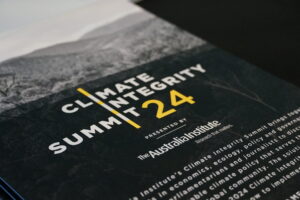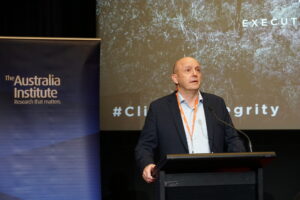This was first published in EcoGeneration online on 20 Jan 2017 and in the print edition.
Prime Minister Malcolm Turnbull put innovation on the national agenda when he defeated PM Tony Abbott in the leadership spill, in September 2015. Turnbull said “We have to recognise that the disruption that we see driven by technology, the volatility in change is our friend if we are agile and smart enough to take advantage of it.“
Then at the UN Climate conference (in December 2015), PM Turnbull had Australia sign up to a side agreement with the EU and 21 other nations called ‘Mission Innovation’, which promised to double government funded R&D into clean energy within five years. Turnbull said, “We do not doubt the implications of the [climate] science, or the scale of the challenge” and professed Australia’s “great optimism and faith in humanity’s genius for invention”.
Unfortunately, after the Coalition’s poor showing at the 2016 federal election it was noted that working class voters fear change to the status quo and so the Liberal leadership moved on. But innovation should be front and centre of the Liberal Party’s approach to energy, because it brings consumers lower bills and more control.
Innovation has always been necessary to solve the technological hurdles of energy transformation. But it is increasingly clear that innovation also helps with the politics, because it lowers bills and appeals to consumers. The energy consumer wants cheaper power and the only way to get it is with new technologies and business models and the market reform to allow them to compete.
Australian companies and inventors are leading the charge already. Reposit is proving a new distributed storage model, Greensync is expanding into Singapore, the Wattwatchers smart energy Auditor is in 10,000 homes and Solar Analytics is selling to the huge US energy market, from Powerhouse, a solar incubator and accelerator in Oakland.
The way to inspire Australians to get behind energy market reform is stories of success like these companies and showing how new technologies have benefits for the economy and the environment. Coal and gas generators are the same as incumbents in any market; they use lobbying to protect themselves from competition. In order to get political support for opening up the NEM to proper competition, energy innovators have to show how they are commercial winners and helping consumers.
Readers of this journal would be advised to learn well the lessons of Australia’s decade-long carbon price debacle. The main lesson is marketing 101: sell the benefits, not the features. Only a small, well-educated minority are interested in innovation per se. The features of battery storage are interesting to us, but the consumer wants to hear about the benefits: lower bills, more control, social esteem, zero emissions.
In order to keep winning hearts and minds and maintain the overwhelming popularity of renewable energy, we have to innovate in how we communicate. We should shift from describing technologies to illustrating the benefits they bring.
We can also use innovation to fight back in the war on renewables. The South Australian blackouts on 28 September 2016 were used to scape-goat wind farms. The fact of course is that renewable energy, storage and smart grids can deliver more reliability and long term resilience than fossil fuels.
Peter Fairley, writing for the Institute of Electrical and Electronics Engineers, points out that networks have been using wind turbines to stabilise electricity supply for more than a decade. Back in 2005 Québec’s grid manager started to require wind farms to provide grid security, through ‘synthetic inertia’ services.
One of the core stabilising functions of baseload thermal plants is to provide ‘inertia’ to energy supply, smoothing out fluctuations. The physical inertia of the turbine is synced to the frequency of the grid and resists deceleration.
When wind turbines are paired with clever inverters and related smart grid technology, they can provide a suite of services that enhance security of supply, including a synthetic version of inertia. If our politicians really want energy security, rather than making uninformed slurs about wind farms they should be asking AEMO and AEMC how best to regulate wind farms so they provide a range of energy security corrections during times of grid instability, from fast response (less than a second) to slow response (many seconds).
Australia’s synchronous, centralised, baseload electricity network is a marvellous technical achievement, but we can do better now. When COAG Energy Council provides a responsible long term vision and directs the regulators to implement it, then we can get to inventing the secure, affordable, decentralised electricity grid.
ARENA’s ESCRI-SA project shows how innovation can transform the grid. AGL, ElectraNet and Woorley Parsons are working together to see how we to deploy a large (up to 20MW, 200 MWh) non-hydro storage facility in SA’s grid, to increase energy security. It would be funded by selling diverse services to the network and the energy markets.
Interestingly, the study found that 40% of the income for a big storage installation could come from market trading, including during high price events and roughly another 40% from delivering ‘unserved energy revenue’, covering for grid failure when the local network islands from it. (If the grid becomes unstable, a sub-section can separate off into a self-sustaining microgrid – like an island – in which, for example, wind plus storage jointly supplies reliable energy to local customers until the grid comes back online.)
But the big wave of storage innovation will only come if the playing field is made level, so storage and demand management can compete fairly. And that will mean less wasted investment on gold plating and lower bills for all energy consumers.
The low hanging fruit for Malcolm Turnbull and his Environment and Energy Minister, Josh Frydenberg, is that delivering these multiple or ‘stacked’ services, will be profitable when energy market rules allow them to be monetised fairly. Emissions reduction and energy productivity will follow, as day follows night. Innovation and competition – what could be a more perfect, honest Liberal Party policy than that?
Between the Lines Newsletter
The biggest stories and the best analysis from the team at the Australia Institute, delivered to your inbox every fortnight.
You might also like
Highlights from the Climate Integrity Summit 2024
2023 has shown us a planet on the brink of collapse. Cyclones, heatwaves, catastrophic floods, fires and landslides have killed people, destroyed ecosystems and decimated communities. And yet Australia is still yet to repair all the homes lost in the Black Summer bushfires of 2020 or the devastating Lismore floods of 2017 and 2022. No
Urgent Need for Australia’s Climate Industry Policy
For the first time in decades, Australia is talking about industry policy.
Opening Remarks: Climate Integrity Summit | Richard Denniss
If we wanted to fix these things, we could. If you think that we need some complicated policy measure or some very expensive investment, you’ve been misled.

